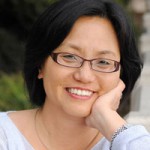When Linda Sue Park was ten years old, she read about 17th century Korean girls of good breeding who were not allowed to leave their homes. To find out about the world beyond their courtyards, they invented the seesaw to catapult themselves high enough to peek beyond the walls. Twenty-seven years later, Park wrote Seesaw Girl (Clarion, 1999) because the image she read about as a child had stuck with her. “When I sat down to write my first book, I knew that would be my idea.”
Seesaw Girl began as a short story for adults, but it didn’t feel complete to Park. During the revision process, she added and expanded until her original 3,000 words became 17,000 or 18,000 words. Only then did she realize she had a novel for young people. “It shouldn’t have surprised me. I was such a fantastic reader at the middle-grade age. The structure of a [middle-grade] novel is hard-wired for me!”
While Park researched Seesaw Girl, she took notes on miscellaneous facts that she knew wouldn’t become part of her story, but which interested her. One of the tidbits she jotted down said Korean 12th century pottery was the best in the world. Park asked herself how they became the best, and created a fictional story to supply the answer. Her Newbery Medal-winning A Single Shard (Clarion, 2001) fell into place after a chance encounter with a photograph of the Thousand Cranes vase. The instant Park saw the vase she knew Tree-ear, her main character, would be its creator, and that her book would chronicle the way in which he acquired the skill to make it.
Park’s other two published books are family books. “My father always offers story ideas and can’t understand why I haven’t written 100 books already.” The Kite Fighters (Clarion, 2000) celebrates her father’s fondness for kite fighting as a boy. Her parents’ experiences as youngsters in Korea during the Japanese occupation provided the inspiration for WhenMy Name Was Keoko (Clarion, 2002). Many of the events in the book happened to Park’s parents or people they knew. For instance, during the occupation, all Koreans were forced to abandon their Korean names and assume Japanese ones. Keoko and Nabuo, the Japanese names of Park’s characters, were also the Japanese names of Park’s parents.
Generally, Park writes between two and four hours a day from her Rochester, New York home that she shares with her husband and two children. As she creates a new story, she’s acutely aware of the craft of writing—choosing the best words to demonstrate her characters’ feelings and thoughts, and guiding her characters through sequences of actions and reactions that resonate with readers. In the past, she’s sometimes been criticized for using vocabulary that’s too advanced for her readers. According to Park, “the story drives me and I pick the word the story needs.”
After Park finishes a novel, she feels burned out and revitalizes herself with poetry. Her first poem was published in Trailblazer Magazine in 1969 at the age of nine, and until lately most of her poems are unpublished. But her alert editor asked if any of her poems could become picture books. Park currently has five picture books under contract, three of which have publication dates (see Upcoming Books).
As a child, Park was an avid reader. To her, writing was a natural extension of reading because she wanted to create stories like the ones she read, but she didn’t consider writing as a profession. Public relations, advertising, journalism and teaching English as a second language took her away from writing fiction. Living in England, she became a successful food and restaurant critic. Park says her mother found this amusing because “I did not ask to cook like other little girls. I wanted to read.” But when she and her husband moved to the States, she couldn’t reestablish herself as a food journalist. According to Park, “I would never have found writing for young people if food journalism had worked here.”


